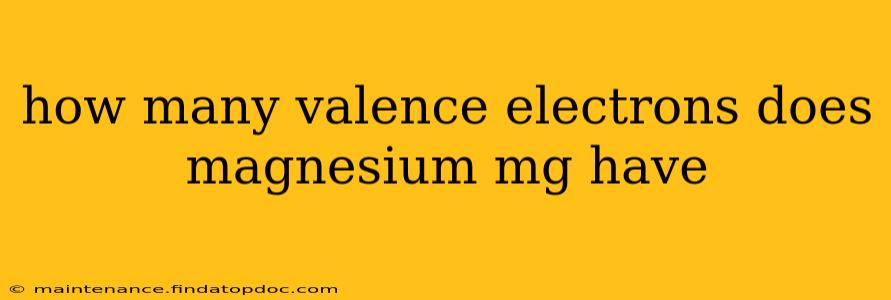How Many Valence Electrons Does Magnesium (Mg) Have?
Magnesium (Mg), a shiny gray alkaline earth metal, plays a crucial role in various biological and industrial processes. Understanding its electronic structure, particularly the number of valence electrons, is key to comprehending its reactivity and chemical behavior. So, how many valence electrons does magnesium possess? The answer is two.
To understand this, let's delve into the basics of electron configuration and valence electrons.
What are Valence Electrons?
Valence electrons are the electrons located in the outermost shell of an atom. These electrons are the ones involved in chemical bonding and determine an element's reactivity. They dictate how an atom will interact with other atoms to form molecules or ionic compounds.
Magnesium's Electron Configuration
Magnesium has an atomic number of 12, meaning it has 12 protons and 12 electrons in a neutral atom. Its electron configuration is 1s²2s²2p⁶3s². This configuration indicates how the electrons are distributed across different energy levels or shells.
- 1s²: Two electrons in the first energy level (closest to the nucleus).
- 2s²2p⁶: Eight electrons in the second energy level.
- 3s²: Two electrons in the third energy level.
Identifying Valence Electrons in Magnesium
The outermost shell of magnesium is the third energy level (n=3), which contains two electrons in the 3s orbital. These two electrons are the valence electrons. They are the furthest from the nucleus and experience the weakest attraction, making them readily available for bonding.
Why are Magnesium's Two Valence Electrons Important?
Magnesium's two valence electrons explain its chemical behavior:
- Reactivity: Magnesium readily loses these two valence electrons to achieve a stable electron configuration similar to noble gas Neon (Ne), which has a full outer shell. This makes it highly reactive, readily forming ionic bonds with nonmetals.
- Formation of Mg²⁺ ions: When magnesium loses its two valence electrons, it forms a stable 2+ cation (Mg²⁺), a common ion in many compounds.
- Oxidation State: Magnesium usually exhibits an oxidation state of +2 due to the loss of its two valence electrons.
How Many Valence Electrons Do Other Elements Have? (A Brief Overview)
Understanding valence electrons isn't limited to magnesium. The number of valence electrons varies across the periodic table and is crucial for predicting the chemical properties of elements. For instance:
- Group 1 (Alkali Metals): 1 valence electron
- Group 2 (Alkaline Earth Metals): 2 valence electrons
- Group 17 (Halogens): 7 valence electrons
- Group 18 (Noble Gases): 8 valence electrons (except Helium, which has 2)
Frequently Asked Questions
Q: How can I determine the number of valence electrons for other elements?
A: The easiest way is to look at the element's position in the periodic table. The group number (vertical column) often corresponds to the number of valence electrons for main group elements (groups 1-18). Transition metals are more complex, and their valence electrons can be less straightforward to predict.
Q: Are valence electrons always involved in bonding?
A: While valence electrons are the primary participants in chemical bonding, it's not always the case that all valence electrons participate. The nature of the bonding (ionic, covalent, metallic) influences the extent of valence electron involvement.
This comprehensive explanation addresses the core question while providing additional context and answering related queries, making it a valuable resource for students and anyone interested in learning about the fundamental properties of elements.
